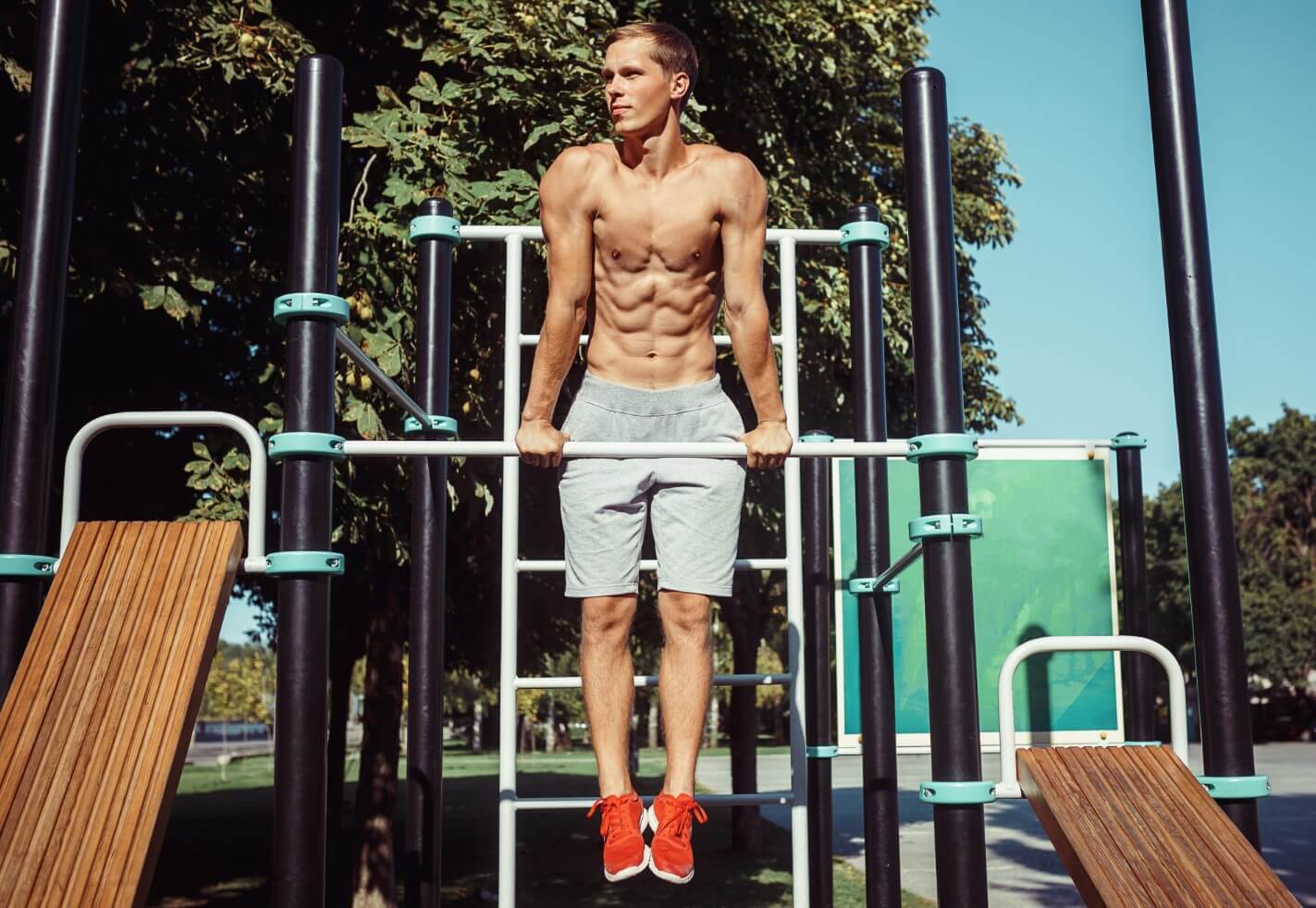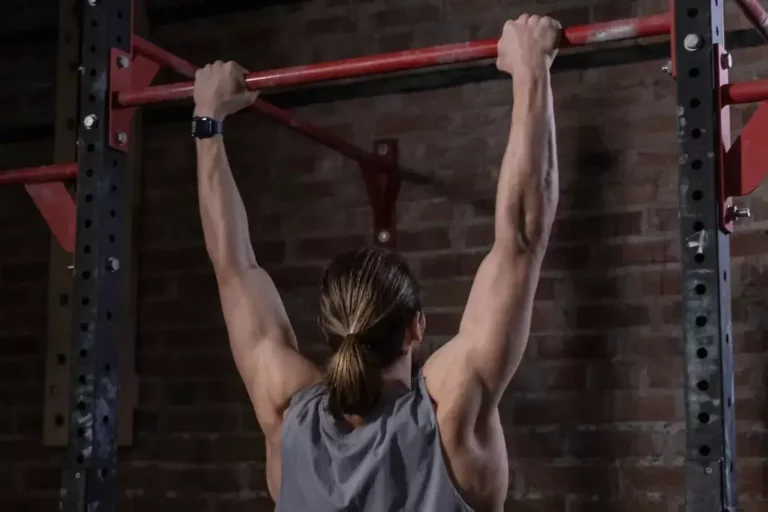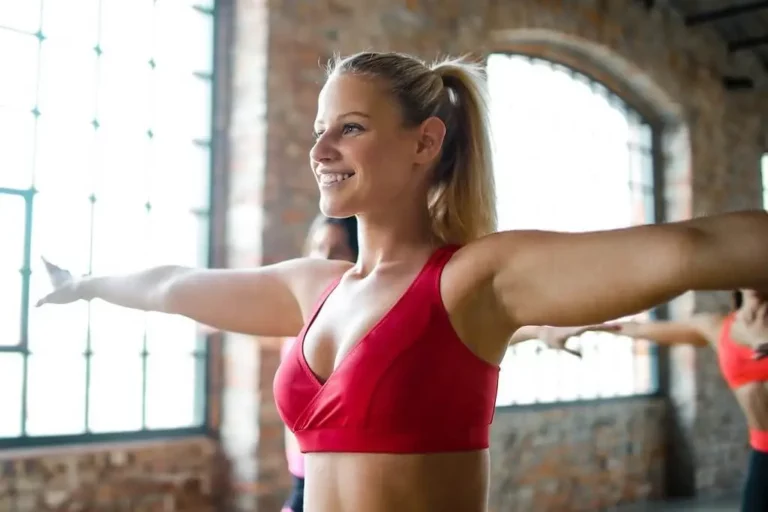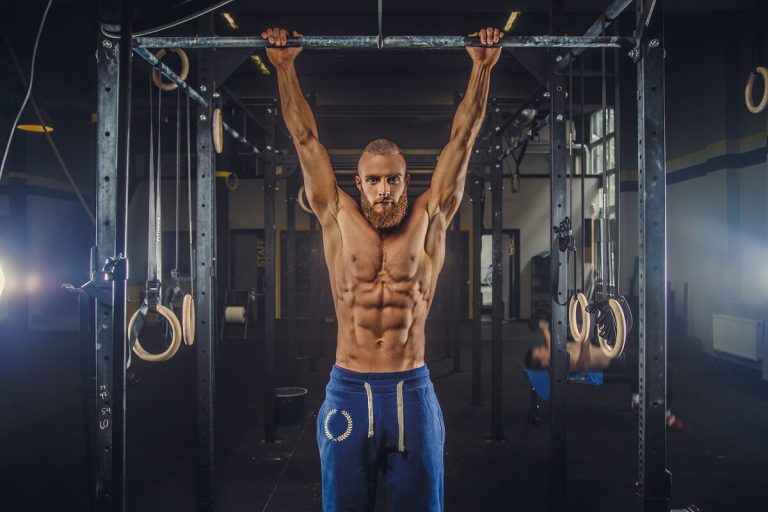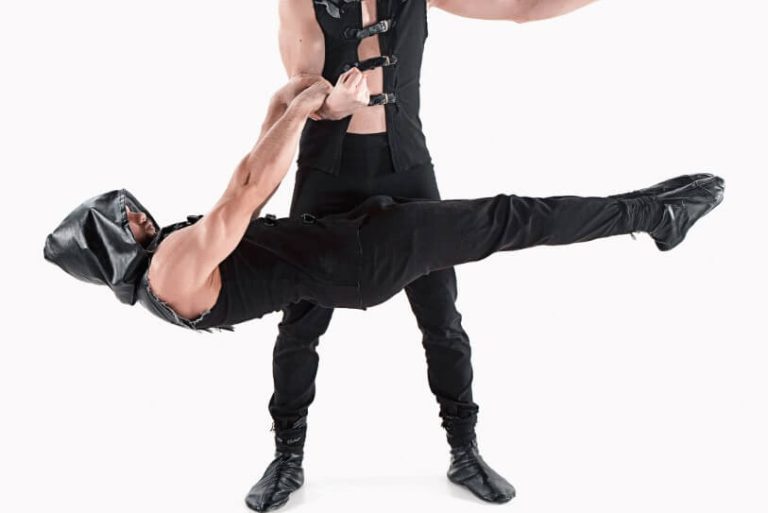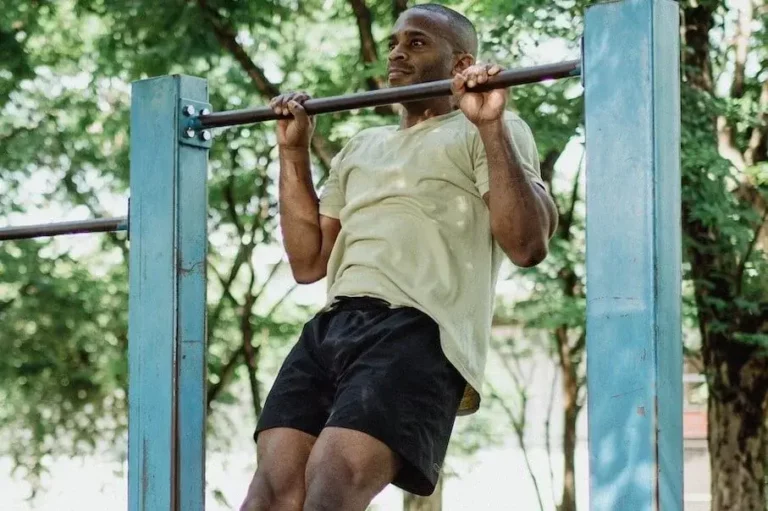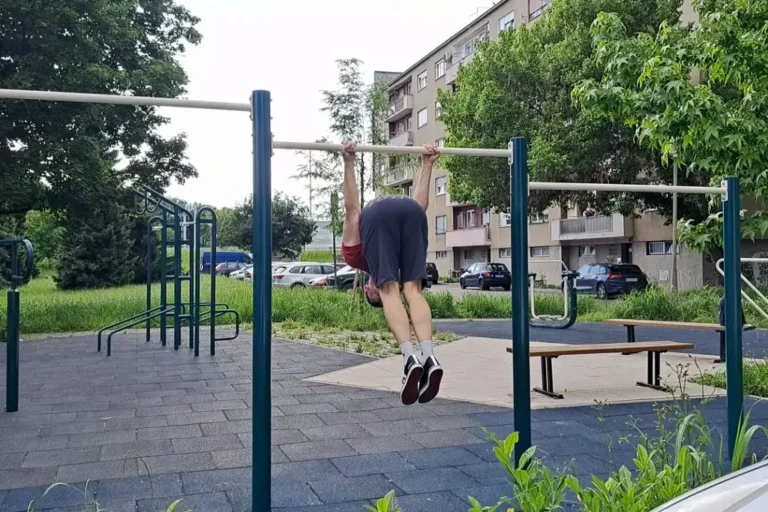Complete Muscle Up Progression To Impress Your Friends
Muscle up progression is one of the most impressive progressions out there.
If I have to single out one exercise that motivated me to constantly train for the last five years, it’s definitely a muscle up. When I first saw it I knew I would not stop until I’m able to do it.
Muscle up progression turned out to be quite a long one. Much longer than I initially expected. I thought I would be able to do a muscle up in a year.
Five years have passed. I overestimated my current capabilities as well as underestimated how much strength it will require to actually do it.
When I started I couldn’t even hang from a bar. I had stabilization surgery on both of my shoulders. However, I thought I would be able to at least hang from a bar. It turned out I couldn’t.
But I didn’t mind the work it took. I like the journey. It turned out the muscle up progression journey is so much fun.
I hope you will be able to see this as a fun endeavor too.
Muscle Up Progression: Muscles Worked
Muscle up is a complex movement consisting of two distinct parts.
The first part is a dynamic high pull up. This is where your back, biceps, and core is doing most of the work.
The second part is a straight bar dip. In this part, most of the workload is on your chest and triceps.
However, most of the muscle up progression will be targeting your upper back and biceps. It’s because of the transferable effect of your push workouts.
Pushing exercises will prepare your triceps and chest. So, doing the straight bar dip will be relatively easy compared to a high pull up.
Muscle up muscles worked:
- Lats
- Traps
- Delts
- Biceps
- Abs
- Triceps
- Chest
Muscle Up Progression: Equipment
To be able to perform muscle up all you need is a pull up bar from which you can freely hang. It’s important that your feet are not touching the ground while you are in the lowest position.
However, to be able to perform some of the exercises in this complete muscle up progression you will also need some other equipment too.
Equipment:
- Pull up bar
- Low bar
- Resistance band
- Box (optional)
Muscle Up Progression: Exercises
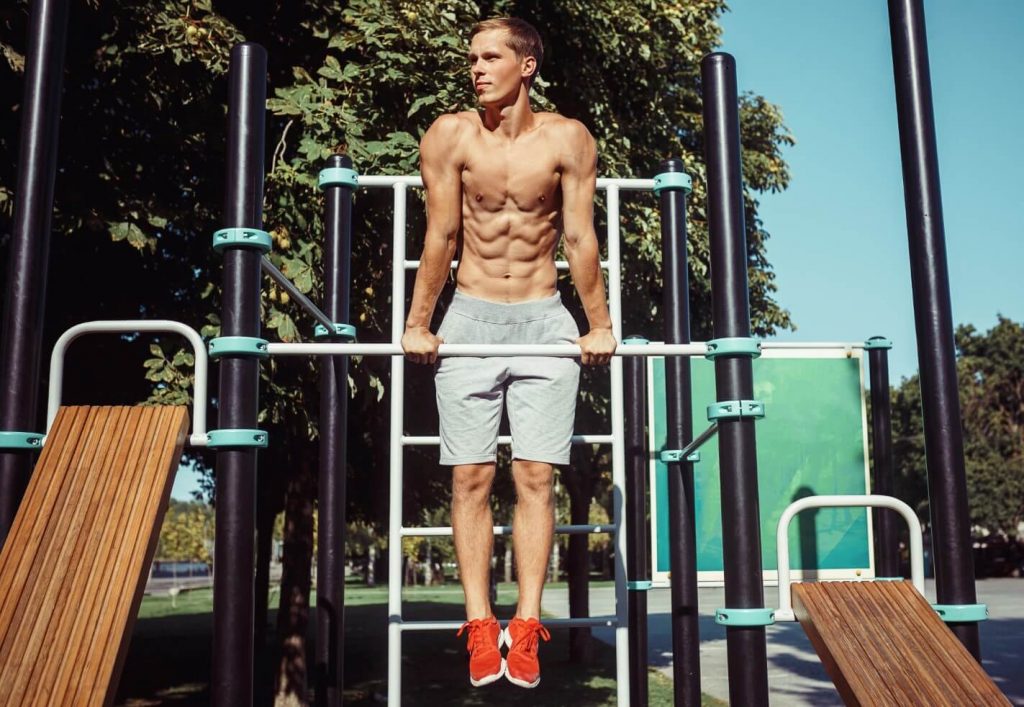
There is a long way from just starting out to a full muscle up. If you are not able to hang freely from a pull up bar like I was when I started, there is quite a journey in front of you.
What’s great about calisthenics progressions, you can easily determine where your starting point is. Typically, this will be a move you are able to do for 5-8 reps in 3 sets. So, you can start from the exercise you are able to do and work yourself up the progression.
But don’t underestimate exercises that are below your current ability level. If you do them, those exercises will help you increase time under tension and help you progress faster.
Progression instructions
You will see that each exercise in a progression is building upon the previous exercise benefits. When you are able to perform the first exercise in a progression, its benefits will help you move on to the next.
You will see that each exercise comes with targeting prerequisites for progressing to the next one. But don’t feel like these prerequisites are set in stone.
Those are just guidelines. If you feel up to it, you can try exercises further up in a progression. Even if you haven’t reached the goal for the current exercise you are working on, doing the harder one may help you progress.
This may in some cases keep you motivated. Especially if you are stuck on one exercise for a while.
Even doing one rep on harder exercise may help you feel progress.
To learn more about how to use progressions to quickly create your own custom workouts check out the Complete calisthenics workout guide.
Muscle Up Levels
To make it easier to follow your progress, exercises are divided into three different levels.
Level 1 will lead you from your first pull up to a chest to bar pull ups.
Muscle up prerequisites exercises – high pull up and straight bar dips are the main focus on Level 2. When you are able to perform each one on its own, you have to combine them in a single movement.
Level 3 is the level on which you finally work on connecting high pull up and straight bar dip into a single movement.
Here are the exercises in progression:
Level 1
- Low bar chest to bar jumps
- Band chest to bar pull ups
- Chest to bar negatives
- Chest to bar hold
- Chest to bar pull ups
Level 2
- High pull up jumps on low bar
- High pull up negatives
- Band high pull ups
- High pull ups
- Straight bar dips
Level 3
- Jump up to a low bar muscle up
- Band muscle up
- Muscle ups
Muscle Up Progression: Level 1
This level is all about progressing with pull ups and chin ups and moving a little bit above the bar. It’s about improving your strength and range of motion.
The main goal of this level is achieving your chest to bar pull ups and chin ups. It will help your body prepare for even harder pulling exercises.
Reaching this level seemed impossible for such a long time for me. Once I was able to reach it, I went through it in a breeze.
One day I wasn’t able to touch the bar with my chest, and after a few months, I was already working on high pull up jumps and high pull ups with a band.
For me, this is a fun phase of a muscle up progression.
Low Bar Chest To Bar Jumps
If you think you are done with a low bar, this exercise will help you feel warm at heart by reusing a low bar again.
When I thought I would never be able to go beyond pull ups and chin ups, this exercise helped me see the light. As soon as I tried it, getting to the next one was easy.
In a matter of days, I was able to incorporate three more exercises into my workout routine. So this exercise was another crucial one in my muscle up progression.
Equipment:
- Low bar
How to perform low bar chest to bar jumps
Positioning:
Start by grabbing a low bar with your hands a bit wider than shoulder width. Your palms will be facing away from you.
Position your legs underneath the bar with your feet on the ground. Your legs should be bent in your knees, so you can jump up to a bar.
At first, your legs will work more. In time, you will want to reduce the jumping as much as possible. The goal is getting to a bar with your chest using your back and arms muscles, not your legs.
Upward movement:
Push with your legs against the floor jumping up. Pull yourself up by flexing your arms in your elbows. Keep on pulling until your chest touches the bar.
You can rehearse touching a bar with your chest with various bar heights. This will help you get familiar with the motion.
Downward movement:
Slowly lower yourself down by extending your arms at your elbows. Keep on lowering down until your legs touch the ground.
Keep on extending your arms and bending your knees to return to a starting position. Move your legs further below the bar if necessary.
Prerequisite for next exercise:
- 3×5 low bar chest to bar jumps
Chest To Bar Negatives
Chest to bar negatives is an eccentric part of a chest to bar pull up. You are doing only the lowering part of a chest to bar pull up exercise.
This is an excellent exercise to help you improve your strength and work yourself up to a full chest to bar pull up.
Equipment:
- Pull up bar
- Box (optional)
How to perform chest to bar negatives
Positioning:
Start by grabbing a bar with your hands slightly wider than shoulder width. Your palms will be facing away from you with your chest touching the bar in the starting position.
Your head should be facing forward like when you are standing.
It would be helpful to use a box on which you will stand to be able to start without jumping to a bar.
If you are not using a box, you should jump up to a bar.
Downward movement:
Lower yourself down as slowly as possible. In the beginning, your descent will last maybe a few seconds. You will notice your progress by increasing the time of descent.
After a while, you will be able to descend for 30 seconds or more.
Prerequisite for next exercise:
- 3x10s chest to bar negatives
Band Chest To Bar Pull Ups
When doing band chest to bar pull ups you will be doing the full chest to bar pull up motion. The only difference is the use of a band.
A resistance band will help you feel lighter. It will decrease the difficulty of the exercise.
This is a great preparation for a full chest to bar pull up because it will familiarize you with the entire range of motion.
Equipment:
- Pull up bar
- Resistance band
How to perform band chest to bar pull ups
Positioning:
Start by grabbing a bar with your hands a bit wider than shoulder width. Your palms will be facing away from you. Hang freely from the bar.
Place your feet inside the band loop.
Upward movement:
Pull yourself up by flexing your arms in your elbows. Keep on pulling until your chest touches the bar.
Keep your head pointed forward. Your head should be in the same position as if you were standing.
Downward movement:
Slowly lower yourself down by extending your arms at your elbows. Keep on lowering down until your arms are completely straight.
Prerequisite for next exercise:
- 3×5 band chest to bar pull ups
Chest To Bar Hold
Chest to bar holds are excellent for loading your muscles in one position without moving. Isometric (holding) exercises are the proven way to increase time under tension and help you build your muscles faster.
Equipment:
How to perform chest to bar holds
Positioning:
Start by grabbing a bar with your hands a bit wider than shoulder width. Your palms will be facing away from you. Hang freely from the bar. Point your toes down.
Upward movement:
Pull yourself up by flexing your arms in your elbows. Keep on pulling until your chest touches the bar.
Hold as long as you can.
Downward movement:
Slowly lower yourself down by extending your arms at your elbows. Keep on lowering down until your arms are completely straight.
If you don’t allow yourself to drop down from a hold, this exercise will be a combination of chest to bar pull up, isometric hold, and a pull up negative.
This will make it harder than just dropping down from a hold.
Prerequisite for next exercise:
- 3x10s chest to bar holds
Chest To Bar Pull Ups
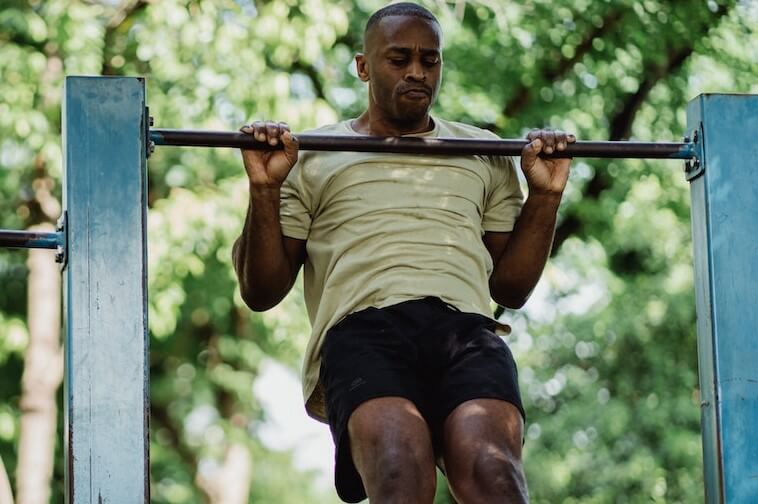
Chest to bar pull ups is another great achievement. A nice milestone to reach.
Once you reach full chest to bar pull ups, this will become your new standard. You will start considering a chest to bar pull up as a “normal” pull up.
It will no longer feel like a chin over the bar pull up is a full range of motion. You will feel as though chin over the bar pull ups are only half pull ups at this point. At least this is how they feel to me.
So, this exercise was another turning point in my muscle up progression.
Equipment:
How to perform chest to bar pull ups
Positioning:
Start by grabbing a bar with your hands a bit wider than shoulder width. Your palms will be facing away from you. Hang freely from the bar. Point your toes down.
Upward movement:
Pull yourself up by flexing your arms in your elbows. Keep on pulling until your chest touches the bar.
Keep your head pointed forward. Your head should be in the same position as if you were standing.
Downward movement:
Slowly lower yourself down by extending your arms at your elbows. Keep on lowering down until your arms are completely straight.
Prerequisite for next exercise:
- 3×5 chest to bar pull ups
Muscle Up Progression: Level 2
This level is about muscle up preparation. Muscle up is a complex movement consisting of two different exercises connected in one.
The first is a high pull up and the second is a straight bar dip. On this level, you will work on both exercises separately.
By reaching this level of expertise you are probably well on your way with your dip strength. I would guess you will have no problem doing the dip part of the muscle up.
But if you were not doing a straight bar variant of the dip, it’s not a bad idea to incorporate it into your workout routine.
In high pull ups you will be working on extending your range of motion even further. You were able to go from chin over the bar pull up to a chest to bar pull up.
Now it’s time to go more dynamic. You will have to use your body, especially your core muscles as a band that will help you pull yourself higher above the bar.
At first, you can target to touch the bar just below your chest. As you grow stronger and your pulls get more dynamic, you should target to go to your belly button.
The last and the highest you would want to be able to pull yourself up to your hips in a high pull up.
So, this is a muscle up progression dynamic phase.
High Pull Up Jumps On Low Bar
This exercise helped me get a taste of high pull ups. It helped me realize I can go higher than the chest to bar. It was only a bit below my chest, but it felt like I was flying over the bar.
Equipment:
- Low bar
How to perform high pull up jumps on low bar
Positioning:
Start by grabbing a low bar with your hands a bit wider than shoulder width. Your palms will be facing away from you.
Position your legs underneath the bar with your feet on the ground. Your legs should be bent in your knees, so you can jump up to a bar.
At first, your legs will work more. In time, you will want to reduce the jumping as much as possible. The goal is getting over the bar with your chest using your back and arms muscles, not your legs.
If you are able to go just a little below your chest at first – great. You will work on going higher in time.
Upward movement:
Push with your legs against the floor jumping up. Pull yourself up by flexing your arms in your elbows. Keep on pulling until your chest is above the bar.
You can rehearse going over the bar with your chest with various bar heights. This will help you get familiar with the motion.
Downward movement:
Slowly lower yourself down by extending your arms at your elbows. Keep on lowering down until your legs touch the ground.
Keep on extending your arms and bending your knees to return to a starting position. Move your legs further below the bar if necessary.
Prerequisite for next exercise:
- 3×5 high pull up jumps on low bar
High Pull Up Negatives
High pull up negatives are an eccentric part of a high pull up. You are doing only the lowering part of a high pull up exercise.
This is an excellent exercise to help you improve your strength and work yourself up to a full high pull up.
Equipment:
- Pull up bar
- Box (optional)
How to perform high pull up negatives
Positioning:
Start by grabbing a bar with your hands slightly wider than shoulder width. Your palms will be facing away from you. You will be touching the bar somewhere below your chest depending on your current ability in the starting position.
Your head should be facing forward like when you are standing.
It would be helpful to use a box on which you will stand to be able to start without jumping to a bar.
If you are not using a box, you should jump up to a bar. However, this would be very hard if you haven’t done any high pull ups so far.
Downward movement:
Lower yourself down as slowly as possible. In the beginning, your descent will last maybe a few seconds. You will notice your progress by increasing the time of descent.
After a while, you will be able to descend for 10 seconds or more.
Prerequisite for next exercise:
- 3x5s high pull up negatives
Band High Pull Ups
When doing band high pull ups you will be doing the full high pull up motion. The only difference is the use of a band. The height of your high pull ups will depend on your current ability.
A resistance band will help you feel lighter. It will decrease the difficulty of the exercise.
This is great preparation for a full high pull up, because it will familiarize you with the entire range of motion.
This is the last exercise I was able to get to in my muscle up progression.
Equipment:
- Pull up bar
- Resistance band
How to perform band high pull ups
Positioning:
Start by grabbing a bar with your hands a bit wider than shoulder width. Your palms will be facing away from you. Hang freely from the bar.
Place your feet inside the band loop.
Upward movement:
Pull yourself up by flexing your arms in your elbows. Keep on pulling until your chest goes over the bar. The height will depend on your current ability.
Keep your head pointed forward. Your head should be in the same position as if you were standing.
Downward movement:
Slowly lower yourself down by extending your arms at your elbows. Keep on lowering down until your arms are completely straight.
Prerequisite for next exercise:
- 3×5 band high pull ups
High Pull Ups
High pull ups are a more dynamic version of a chest to bar pull up. It will require a bit of swinging motion to be able to snap dynamically and exert enough energy and speed so you can pull your body up high over the bar.
Equipment:
How to perform high pull ups
Positioning:
Start by grabbing a bar with your hands a bit wider than shoulder width. Your palms will be facing away from you. Hang freely from the bar. Point your toes down.
Upward movement:
Pull yourself back a little to initiate a slight swing backward. When your body swings back, aim with your toes pointing down a few inches in front of you.
Snap up dynamically by flexing your arms in your elbows. Keep on pulling until your chest is over the bar. The height of your high pull up will depend on your current ability.
Keep your head pointed forward. Your head should be in the same position as if you were standing.
Downward movement:
Lower yourself down by letting your body travel behind the bar. Keep on lowering by extending your arms at your elbows.
Keep your legs under control. Point with your toes a few inches below the bar.
Lower down until your arms are completely straight and your body swings a little forward. This is your queue for the next snap up.
Prerequisite for next exercise:
- 3×3 high pull ups
Straight Bar Dips
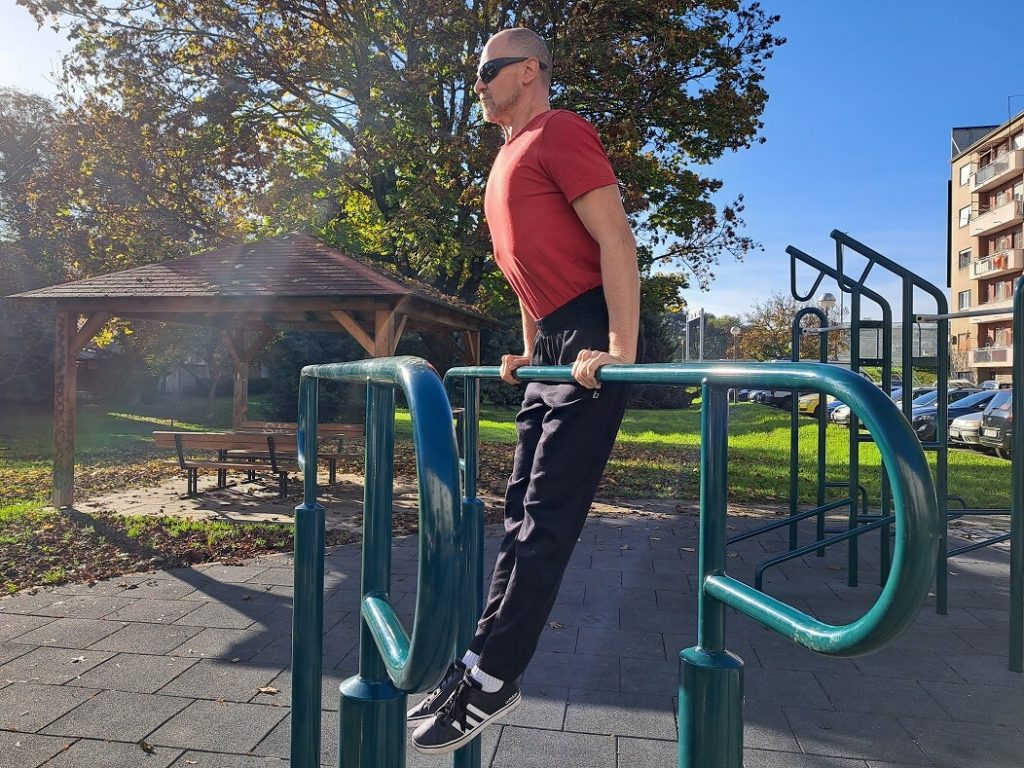
Straight bar dips are an excellent exercise for working your chest and triceps. So far you were doing only pulling exercises. It’s different from everything else in this progression because this is a pushing exercise.
For me, this exercise is pretty easy. I never struggled with pushing exercises. So even without doing it as a part of my muscle up progression, this exercise is no problem for me.
Equipment:
- Dip bars (or low bar)
How to perform straight bar dips
Positioning:
You start by grabbing a bar with your palms facing away from you.
Depending on the height of the bar you have access to you might need to jump up to a bar to get to a starting position.
Jump up to a bar so that your arms are holding to a bar straight down to your sides. Your arms are holding your entire weight with your feet not touching the ground.
Your hips are touching the bar. Keep your upper body straight while your legs are slightly bent in your hips.
Downward movement:
Lower yourself down by flexing your arms at your elbows. Keep lowering until your upper arm forms a 90 degrees angle with your forearms.
This is the lowest point of downward movement.
When lowering down, your upper body is leaning forward. Let your legs go forward under the bar so you can keep balance.
Don’t allow your upper body or your legs to touch the bar during the movement.
Upward movement:
To initiate upward movement push yourself up by straightening your arms in your elbows. Keep on pushing until your arms are straight. This is the highest point of upward movement.
During the entire movement concentrate on not touching the bar with anything but the hands that are grabbing the bar.
Prerequisite for next exercise:
- 3×5 straight bar dips
Muscle Up Progression: Level 3
Up until this point, it was all about strength and preparing your body for a full muscle up bit by bit.
Now you have all elements needed. On this level, it’s about connecting everything in one smooth movement.
This is a muscle up progression completion phase.
Jump Up To A Low Bar Muscle Up
You have been doing high pull ups so this exercise may be easy for you. Concentrate on performing a complete muscle up.
Equipment:
- Low bar
How to perform jump up to a low bar muscle up
Positioning:
Start by grabbing a low bar with your hands a bit wider than shoulder width. Your palms will be facing away from you.
Position your legs underneath the bar with your feet on the ground. Your legs should be bent at your knees, so you can jump up to a bar.
Upward movement:
Push with your legs against the floor jumping up. Pull yourself up by flexing your arms in your elbows. Keep on pulling until your chest is well above the bar.
When you push yourself from the ground with your legs concentrate on pulling hard to do a high pull up. When you are at the end of a high pull up, lean forward with your chest over the bar.
In this position just extend your arms and perform a straight bar dip until your arms are straight.
Downward movement:
Lower yourself down by pushing away from the bar. Allow your body to sink behind the bar while keeping control over your legs. Point your legs to go under the bar. Keep on lowering down until your legs touch the ground.
Keep on extending your arms and bending your knees to return to a starting position. Move your legs further below the bar if necessary.
Prerequisite for next exercise:
- 3×3 jump up to a low bar muscle up
Band Muscle Ups
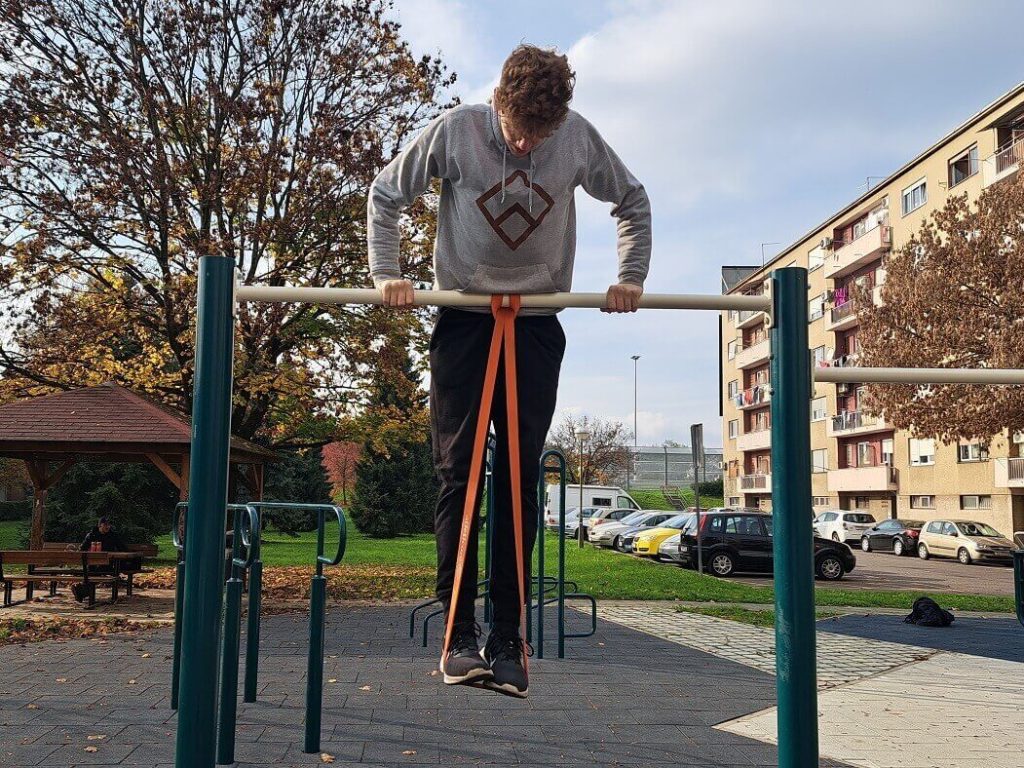
When doing band muscle ups you will be doing the full muscle up motion. The only difference is the use of a band.
A resistance band will help you feel lighter. It will decrease the difficulty of the exercise.
This is a great preparation for a full muscle up because it will familiarize you with the entire range of motion.
Equipment:
- Pull up bar
- Resistance band
How to perform band muscle ups
Positioning:
Start by grabbing a bar with your hands a bit wider than shoulder width. Your palms will be facing away from you. Hang freely from the bar.
Place your feet inside the band loop.
Upward movement:
Pull yourself back a little to initiate a slight swing backward. When your body swings back forward, aim with your toes pointing down a few inches in front of you.
Snap up dynamically by flexing your arms in your elbows. Keep on pulling until your chest is well over the bar.
When you are at the end of a high pull up, lean forward with your chest over the bar.
In this position extend your arms and perform a straight bar dip until your arms are straight.
Downward movement:
Lower yourself down by pushing away from the bar and letting your body travel behind the bar. Keep on lowering by extending your arms at your elbows.
Keep your legs under control. Point with your toes a few inches below the bar.
Lower down until your arms are completely straight and your body swings a little forward. This is your queue for the next snap up.
Prerequisite for next exercise:
- 3×3 band muscle ups
Muscle Ups
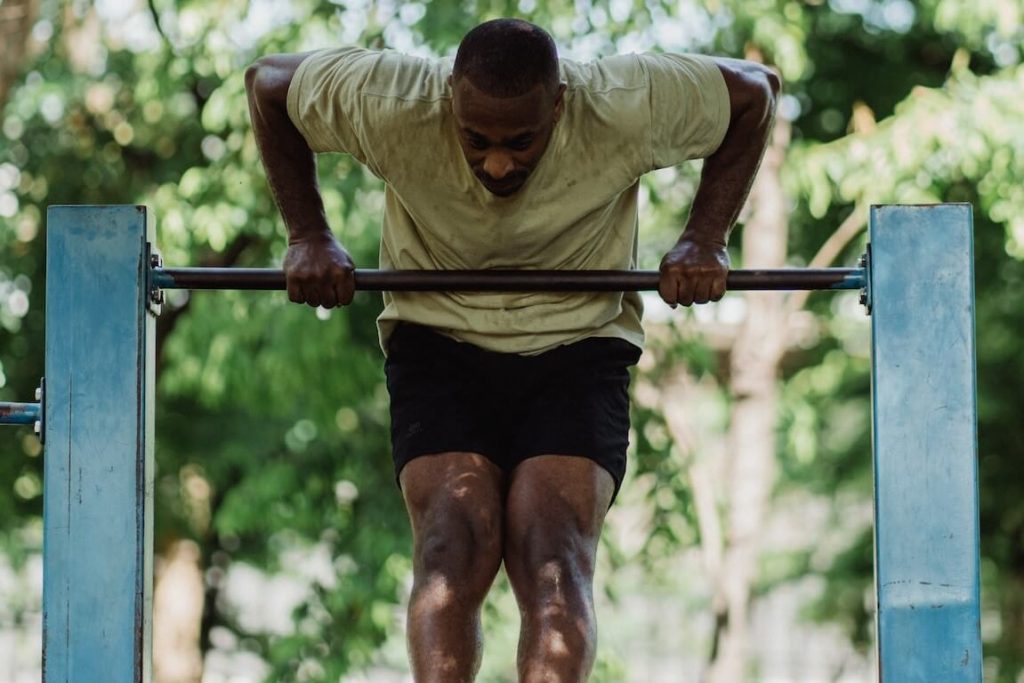
It’s finally time for your first muscle up. This is the final exercise in muscle up progression.
Equipment:
How to perform muscle up
Positioning:
Start by grabbing a bar with your hands a bit wider than shoulder width. Your palms will be facing away from you. Hang freely from the bar.
Upward movement:
Pull yourself back a little to initiate a slight swing backward. When your body swings back forward, aim with your toes pointing down a few inches in front of you.
Snap up dynamically by flexing your arms in your elbows. Keep on pulling until your chest is well over the bar.
When you are at the end of a high pull up, lean forward with your chest over the bar.
In this position extend your arms and perform a straight bar dip until your arms are straight.
Downward movement:
Lower yourself down by pushing away from the bar and letting your body travel behind the bar. Keep on lowering by extending your arms at your elbows.
Keep your legs under control. Point with your toes a few inches below the bar.
Lower down until your arms and body are completely straight.
This concludes a muscle up progression – one of my favorites.

